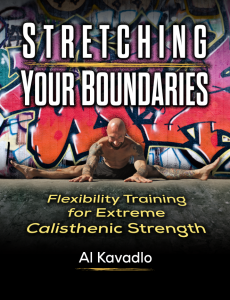Pat: Al Kavadlo is a strong and bendy, tatooed gentleman. He does great work–and he knows that. I hope you enjoy this minimalist stretching/assessment routine Al put together for you. If you have any questions, either for Al or myself, please drop them in the comments on down yonder.
AL: Perhaps the most important key to success in fitness is to keep things from getting unnecessarily complicated. That’s a big part of why calisthenics is so appealing to me; I love the simplicity of training with nothing but my own bodyweight. As a personal trainer, I especially love workouts that can be done anywhere/anytime. No excuses!
I’m a big proponent of basic calisthenics exercises like squats, push-ups and back bridges. For many people, however, the range of motion required to get the most out of these strength training exercises exceeds their current abilities. Strength and mobility are more intimately connected than many people realize. True functional strength includes the ability to move with a full range of motion. Though mobility is important, it doesn’t mean your flexibility training needs to take over your life.
Fortunately, flexibility work requires very little space or equipment, and it doesn’t take very long to begin reaping the benefits. Here are five quick stretches you can try right now wherever you are. Use them to assess your flexibility and you will quickly get a good idea of which areas you may need to work on.
1. Bend over and touch your toes with your knees locked. (Pat: When working this stretch, actively push the hips back and drive your hands into your shins with locked elbows to really milk it).
2. Get into a deep squat position with both heels flat on the floor and your calves and hamstrings in contact with one another. (Pat: If a deep squat isn’t happening for you right now, you can start to break up the hips with the frog stretch).
3. Lie flat on your back with your legs straight and lower back in contact with the ground. Reach your arms overhead with both wrists flat on the floor behind you with minimal flexion at the elbows.
4. From a standing position, pick up one leg and place the outside of your ankle on a bench, bar or other object that is just below waist height. Now rotate your hip to touch your knee to the object as well (your shin should be perpendicular to your body.)
5. Reach both arms behind your back – one from above, one from below – and touch the tips of your middle fingers together.
Nowadays, most adults are unlikely to pass all of these requirements, so don’t feel bad if you’ve failed at one or more of these tests. Once you identify your tight areas, you can work toward gradually improving your range of motion.
For more information, check out Al’s new book, Stretching Your Boundaries – Flexibility Training for Extreme Calisthenic Strength.

Number 4 is possible but tough, any suggestions for improving my mobility in this area?
Valuable and inspiring information. An essential component of training often ignored through ignorance but in my opinion all training is worthless without increased flexibility.